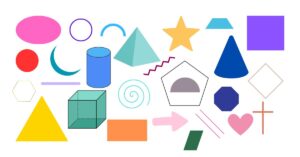Here’s why you need to know the recommended math milestones for kids by age.
One, it will help you gauge whether they are doing well in the subject or not. I was shocked to realize multiplication is a grade two topic now, not grade 4.
Two, if you know what math skills kids cover in that age or grade, you can help them master the concepts better. As we said, parents have a huge role to play in math mastery than we have previously thought. In many cases, this is what differentiates kids who are doing better in class from those who aren’t.
I’d also like to add that knowing what math skills a child should have by age helps diagnose dyscalculia and other conditions. That said, children are not the same, so what is easy for one may be Greek for another. This, combined with the amount of practice and help a child gets at home, is what makes the difference
Math Skills for Kids by Age
Toddlers Ages 1-3 Years
- Sort objects by size, color and shape
- Recite numbers 1-10, but can skip and confuse some
- Understand math vocabulary like more, small, big
- Match shapes and colors
- See patterns in daily life
You can help them by playing math games or singing math (counting) songs together, buying number and shape toys or puzzles and reading them stories. Technology, such as children’s TV channels and apps, also plays a big role because the new generation of kids also uses technology to learn.
Preschoolers Ages 3-4 Years
- By pre-school, kids can count to 20 or more
- Know the relationship between the number 5 and five, and they can show you with fingers or objects how many that number refers to
- Can write numbers in the correct order
- Recognize shapes by name and can identify and draw them
- Can put a simple puzzle together
- Can classify things by height, length, gender
Keep counting things every chance you get, write numbers 1-10 or use toys to place them in order, name shapes and ask a lot of questions about height, length, volume etc.
Kindergartners- PrePrimary Ages 5-6 Years
- Â Can count to 50 or higher and skip count easily. Read our blog on how high a 5-year-old should count to learn more about what to expect.
- Identify the larger or smaller of two random numbers
- They can do simple sum or subtraction with their fingers, toys or with a pen and paper
- They start understanding time concepts like morning and evening or days of the week This is where they learn there’s no school on Saturdays, and Sunday is for church
They can follow multi-step instructions such as first, next, and after.
Doing problems is the best way to teach math at home from this age onwards. The more practice and encouragement a child gets, the more they understand math concepts.
First and Second Graders Ages 7-8 Years
- Count to 100, skip count to 1000 and can recognize and write all those numbers.
- Do basic arithmetic (add, subtract, multiply)
- Know the place value of numbers
- Can predict what comes next in patterns
- Can recognize the value of money. They know multi-dimensional shapes such as cubes and cones
- Can solve simple word problems
- Can read time in both digital and manual clocks
Third to Fifth Graders Ages 9- 11
- Solve detailed word problems
- Tackle fractions and decimals
- Start two and three-digit multiplication and division
- Master place values enough to round off figures
- Compare numbers- greater than, less than, equal to
- Start learning the multiplication table
- Introduction to area, perimeter and mass

Junior Secondary School – JSS (Ages 13-15)
This stage is a buildup of everything kids learn in lower classes. However, they do get introduced to algebra, percentages, geometry and advanced measurements. Mastering introduction to these concepts in fifth grade is crucial so as not to get lost in the complications.
I also recommend looking at different ways to tackle them because people understand things differently. YouTube and math apps have been instrumental in finding new and simpler ways to understand things like algebra and calculus.
A child will recognize random numbers between ages 3 and 4 unless they are really bright. At age 3, they can recognize any number 1-10, and even write it. By age 4, they progress to 11-30 or higher, and they can pick out any number you mention in a line-up.
A 5-year-old can count to 50 or higher, recognize random numbers and write them down. At this kindergarten level, they can also do simple sums, know about larger or smaller numbers and recognize time and days. They also draw and recognize shapes as well as count backward.
A child in grade one should have a good mastery of counting and recognizing numbers, simple sum and word problems, place value and patterns. They can also read a digital clock; some can do a normal one. Shapes, two-digit puzzles and comparisons are also right up their array.





